Mary Beard is a Professor of Classics at Cambridge University, where she is a fellow of Newnham College. She also writes a blog for the Times, called A Don’s Life, and she is the editor of an excellent new series of books, The Wonders of the World.
The latter is “a small series of books that will focus on some of the world’s most famous sites or monuments.” It is published by Profile in the UK, and by Harvard University Press in North America.
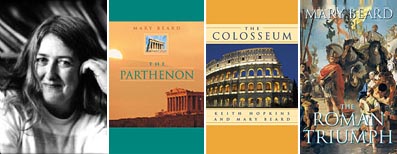 A few notable titles in that series include Mary Beard’s own book about The Parthenon; her collaboration with Keith Hopkins for The Colosseum; Cathy Gere’s extraordinary look at The Tomb of Agamemnon (previously discussed on BLDGBLOG here); and many others, including books about Westminster Abbey, The Temple of Jerusalem, and The Alhambra, with other titles ranging from the birth of Egyptology to the history of British railways and the First World War.
A few notable titles in that series include Mary Beard’s own book about The Parthenon; her collaboration with Keith Hopkins for The Colosseum; Cathy Gere’s extraordinary look at The Tomb of Agamemnon (previously discussed on BLDGBLOG here); and many others, including books about Westminster Abbey, The Temple of Jerusalem, and The Alhambra, with other titles ranging from the birth of Egyptology to the history of British railways and the First World War.
Meanwhile, Beard has another, highly anticipated book forthcoming from Harvard University Press: The Roman Triumph. Among other such questions, that book will ask: “what are the implications of the Roman triumph, as a celebration of imperialism and military might, for questions about military power and ‘victory’ in our own day?”
In the following two-part interview, Mary Beard talks to BLDGBLOG about the Wonders of the World series, including how and why the particular buildings and monuments have been chosen. We discuss the politics of archaeology and the often misguided reappropriation of the past; whether or not sites of historical horror can be transformed into places of both wonder and critical reflection; why we still know so little about the ruined city of Pompeii; how museums, guidebooks, and films, from Gladiator to 300, represent the Classical past; and even ancient Roman analogues for the death of Saddam Hussein.
Part Two can be found here.
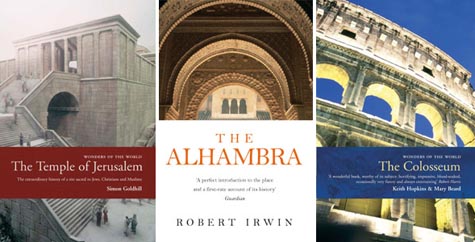
• • •BLDGBLOG: To start with, what are the basic editorial intentions behind the
Wonders of the World series? For instance, who are the books for?
Mary Beard: You sometimes wonder whether you reinvent your editorial intentions as you go along! But I suppose there are three intentions. The first is that I want these books to open up culture and history, as well as dissent about culture and history, through the contested life stories of individual monuments and wonders – real or imaginary. I think it’s about using a single object – a single monument, a single wonder – as a kind of window onto not just culture and history but also the controversies of culture and history. That’s number one.
Number two – and these are not meant to be hierarchical – is quite a simple one, and it’s to show that bricks and mortar, or concrete and marble, are always more than that. A great building is always more than the sum of its parts: it’s about mythology; it’s about argument; it’s about cultural re-use and re-presentation.
And I think the third intention is that you want to help people to enjoy looking at monuments, and at the complexity of monuments – and to see that the complexity and the arguments are what’s fun about this. Sometimes, when people write for what they think of as a popular market, they think that they should make it simple, whereas I think that what you should be doing is helping people to enjoy how complicated it all really is.
Of course, some of these buildings work better for one of those functions rather than others – but that’s the overall theme.
 BLDGBLOG: When it comes to choosing an author to produce these books, do you go after people whose scholarly work you already admire – or do the authors come looking for you, pitching you ideas for a new monument or Wonder?
BLDGBLOG: When it comes to choosing an author to produce these books, do you go after people whose scholarly work you already admire – or do the authors come looking for you, pitching you ideas for a new monument or Wonder?
Mary Beard: Increasingly, as people know the series, they’re starting to come forward and say, “I’ve got a great idea.”
I think the key to it, though, is: one, they can’t be dull. I call it “academics with attitude” – they’ve got to have some sense of chutzpah about them. But I don’t think attitude is enough; I think the key is the kind of marriage you make between the writer and the monument – how you can make it work by getting the pairing right. That is, I think, quite difficult.
One of the best examples I can think of is that we’ve been looking for someone – and may possibly now have found somebody – to do the Tower of London. Years ago I went out for lunch with Simon Bradley, an architectural historian, to talk about the Tower and whether he’d like to do it. He looked like a good prospect. So we were having lunch, but as we talked on and on about it, I got the sense that both of us were becoming just a bit bored with the blasted Tower of London. After a good drink or two, I finally said: “Look, Simon – forget the Tower. If you could have any building in the world, what building would you really, really like to write about?” And he instantly said: St. Pancras Station. Then it all came out: he was an architectural historian of the Gothic Revival by training, and he’d been a train enthusiast when he was a kid, and, suddenly, you saw: God – there was a building just waiting for the bloke. And, actually, it’s turned out to be an absolutely wonderful book.
It’s that kind of slightly unlikely marriage that makes them work best – it’s about being a kind of dating agency.
But there was something back in question one which we didn’t do – which is who the books are for. And we’re wanting to have as many readers as possible. Those might be specialists, or teachers, or high school students, or the man on the bus; but I think there is always a central nugget of people in the middle that I’ve got in mind when I’m commissioning a book, and I call them the intelligent ignorant.
BLDGBLOG: [laughs] I suppose I’m in that category.
Mary Beard: And I’m quite good at being the clever ignorant, too!
This goes back to what I said: people write popular books wanting to make things simple. I’m imagining that somebody who comes to this series may be ignorant, in the sense that they know nothing about the building they’re about to read about, beyond its name, or a very few facts – so they are, technically, ignorant. But I’m also assuming that they’re intelligent. What they do not want is to be shortchanged by oversimplification – and they do not want to be talked down to. They’re not going to take crap.
So lots of specialists will pick up these books, in the way that they always do, but my target audience is the intelligent ignorant.
 [Image: The interior iron arches of London’s St. Pancras Station, via Wikipedia].
[Image: The interior iron arches of London’s St. Pancras Station, via Wikipedia].
BLDGBLOG: How much thought goes into choosing the actual sites?
Mary Beard: Quite a lot. This started off by me wanting to write about the Parthenon, and wanting to write about it for all the reasons that I’ve glossed as the editorial objectives of the series. But then it grew – and we saw that there was mileage in the idea.
BLDGBLOG: I can think of a dozen or so places that would make fantastic books – the catacombs of Paris, the Maginot Line, Hoover Dam, Cape Canaveral, and so on – maybe even the International Space Station – but perhaps those don’t really fit the editorial mission of the series. Do sites like those have any interest for you?
Mary Beard: Again, we want to range from the absolutely bog-standard, normative greatest hits that would be on anybody’s idea of a Wonder of the World, while, at the same time, we want to increase the range of those Wonders. There’s a trade off there, between not wanting to be boringly predictable, and, on the other hand, not wanting to be maverickly odd.
One of things I want to do is to take some of the greatest hits, like St. Peter’s and Stonehenge, and show people how interesting and complicated and different they are – different from what those people might have imagined. But I also want to take things that people might never have thought of putting in the category of a Wonder.
BLDGBLOG: Like St. Pancras?
Mary Beard: I think St. Pancras in England is an absolutely extraordinary building, and, behind it, the rail sheds are incredible – in the engineering and in the architecture. It’s absolutely marvelous. So I’m very pleased to do that.
Similarly, with something like Gavin Stamp’s The Memorial to the Missing of the Somme: what happens if you take something that people would say, “Oh, a war memorial” – and you say, no: think of it in a different way. Think about this as a Wonder of the World. And then you think about that monument differently.
But I don’t know how far you can go down that line of being subversive. In some ways, we’re always teetering on the margins of where we might go next. One of the things that I’ve often said is: I wonder what happens if you do Auschwitz? Can you do sites of horror? Can you turn wonder around in that way?
It would be hard to know how to do that in the series in a way that isn’t mawkish or that, in some way, makes the monument tawdry. It’s hard to know.
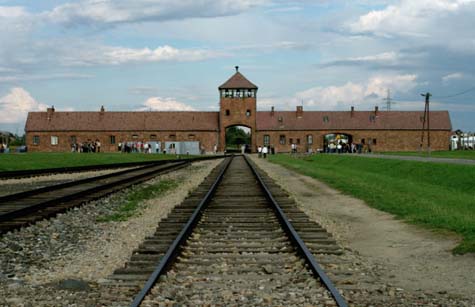 [Image: Tourists visiting Auschwitz-Birkenau; photo via Wikipedia].
[Image: Tourists visiting Auschwitz-Birkenau; photo via Wikipedia].
BLDGBLOG: That’s interesting, actually, because there was a short article in New Scientist a few months ago about the rise of so-called dark tourism – where people visit sites like Auschwitz and the Cambodian Killing Fields. So there is a connection between wonder and horror.
Mary Beard: There was a book – which was not in the series, but which was published by Profile – by William St. Clair, about Cape Coast Castle, a British slave-trading castle on the west coast of Africa. That turned out to be extremely interesting. It expanded from being a Wonder partly because he found an enormously rich set of unexploited documentation.
But we did talk quite a lot about whether the slave trade could produce wonder – if the slave trade could produce a Wonder of the World – and what that would mean.
 BLDGBLOG: Most of the books now focus on sites around the Mediterranean – with some exceptions, but those exceptions are all European. Do you see the series going on to include non-European sites like Macchu Picchu or the Taj Mahal?
BLDGBLOG: Most of the books now focus on sites around the Mediterranean – with some exceptions, but those exceptions are all European. Do you see the series going on to include non-European sites like Macchu Picchu or the Taj Mahal?
Mary Beard: Well, it is a bit European. In fact, one of the things about our list at the moment, and this is something that I really want to do something about, is that the Americas are striking by their absence. That’s something that’s on my mind. We have got the Forbidden City coming up, and the Taj Mahal, too – but there’s a striking lacuna where America, North or South, is concerned, and that’s something I want to think hard about.
I’m also interested in natural wonders: the Grand Canyon is only made a natural wonder by cultural re-appropriation. Without that, it’s just a canyon. So why not the Grand Canyon? Similarly, too, the Alps were any old mountains – till they became Mountains. And the Lake District was just boggy hills till the blasted poets got at them.
I think the boundaries of the Wonders of the World series are interesting – but, in the end, if all you did was invest in the margins, without re-looking – and I think it is a radical re-looking – at some of the things which seem more familiar, it would be a bit of a waste.
BLDGBLOG: In other words, doing a book about Cape Canaveral would be a little too avant-garde.
Mary Beard: I would go with a monument of space technology, actually, because I think you’d read it differently within the series. It’s just that I wouldn’t have too many volumes on Cape Canaveral and other things like that. It’s a question of productive balance.
In the long term, I hope that the books will rub off on one another: you’ll read Westminster Abbey differently because you’ve read it after you’ve read about Cape Canaveral – and vice versa. If people like the series, and if they trust it, if they feel that there’s a guarantee of a decent read, then they’ll be encouraged to read things that they wouldn’t otherwise have read. I hope that’s what happens.
 BLDGBLOG: I thought Cathy Gere’s book, The Tomb of Agamemnon, was incredible – in large part because it demonstrates how easily archaeology can become politicized. From your own experience, how easy is it for archaeological research, or just basic historical research, to become politicized – for the past to be deliberately reinterpreted in a way that benefits certain political narratives in the present?
BLDGBLOG: I thought Cathy Gere’s book, The Tomb of Agamemnon, was incredible – in large part because it demonstrates how easily archaeology can become politicized. From your own experience, how easy is it for archaeological research, or just basic historical research, to become politicized – for the past to be deliberately reinterpreted in a way that benefits certain political narratives in the present?
Mary Beard: That was one case where, even though I know a bit about prehistoric Greece, and I’ve done stuff on Schliemann, I fell into the category of the intelligent ignorant. I had really very little clue quite how loaded the tomb of Agamemnon became. It was extraordinary.
It does seem to me that all these books do, in a sense, is say: look, these buildings matter. They’re not just bricks and mortar. They’ve been fought about. People want to own them, to make them theirs – because they know that they’re important. Quite how that happens I think is always an important story. It’s a way to find out more about political culture by a back door.
In some ways, one learns a lot about the Nazification of Western Europe by thinking about Mycenae. But there’s also a sense of ownership going on here, in a more general sense – and, certainly, the Getty is a good place to sense that. There is an interesting problematization at the moment about cultural ownership, which is: do we think culture is moveable and global and shared? Or do we think that culture is national, and it belongs to the soil on which it was created? Should culture be owned by the people whose ancestors created it?
I saw a statement quite recently – I don’t know if he was correctly quoted – by the Greek minister of culture, saying that, in his ideal world, everything produced in Greece would be in Greece. At that point you think: right, this is not about the restitution of things that have been illegally bought or smuggled or whatever; this is about a particular version of archaeological nationalism. At that point I start to feel very uneasy – and I would hope that these books help people to see that a narrowly vulgar archaeological nationalism is a very problematic idea.
I was in the Met relatively recently, and I was walking through those rooms that have been reconstructed from British country houses, and I thought: do I feel pleased that these rooms are here? Or do I feel like what have you got your hands on these for? Which do I feel? Obviously, to some extent, you feel both – but on balance I feel more pleased than cross, because the idea that bits of my culture can be found globally, that I can go into a museum in New York and see something from Gloucestershire, actually pleases me as much as it makes me anxious.
I did also go to the Mellon Center for British Art, in New Haven, a few weeks ago – a marvelous collection of British art. It made me say: here I am, a very well-educated, cultural middle-class Brit, and this collection of British art in New Haven, displayed in a way that I’d never seen British art displayed before, has made me think differently about my own culture, in a way that would have been impossible had these been in the UK.
So, leaving aside the fraught issues of criminality or theft, which is one thing, the idea is whether we can think of these things as bits of shared cultural property. I mean, what happens when a building becomes a Wonder of the World? One of the interesting consequences, I think, is a series of tough questions. In what sense do we own these things? In what sense can these things really be shared? Do we feel pleased that there’s a bit of the Parthenon in the Louvre – or do we think it should go back?
I increasingly come down on the side of feeling pleased – although ambivalent.
 BLDGBLOG: I think a lot of this, though, comes down to the specific historical relationship between the countries involved. The U.S. having British artifacts in a museum means one thing, whereas, say –
BLDGBLOG: I think a lot of this, though, comes down to the specific historical relationship between the countries involved. The U.S. having British artifacts in a museum means one thing, whereas, say –
Mary Beard: Having the Benin bronzes means quite another.
BLDGBLOG: Exactly. It has a different set of political implications. But that’s also why it can be hard sometimes to distinguish between archaeology as a science, and archaeology as a political pursuit – politics, or even empire, pursued by other means.
Mary Beard: Yes – I think there’s always a trade-off, and it’s always murky. Different sides will tell you different stories and give you different interpretations of exactly the same series of events.
I think you can see that very clearly with Mussolini. It is one of the clearest cases: you could say that Mussolini was re-excavating Ancient Rome in order to make a political statement about his own genealogy. He wasn’t saying: “Wouldn’t it be interesting to know what the Mausoleum of Augustus looks like?” He was trying to excavate the monumental center of ancient Rome as a legitimation of his own regime.
It’s clear that’s why the money went in. It’s not half so clear that the individual archaeologists, in receipt of that money, were on message in quite the way that they appear to have been.
Some time ago I got a group of my colleagues in Cambridge together. All of them were eighty and over, and all of them had been in Italy when the big Mussolini excavations were going on. One of them was an ex-member of the Communist party; others were highly unpoliticised. I got a group of students, interested in finding out about this, to ask the group questions about what being in Rome in the 1930s was all about. I expected at least the highly political ones would give me, possibly an anachronistic reading, but a very political reading about distaste for the appropriation of archaeology for political ends. I couldn’t have been more surprised – because every single one of them said, “It was amazing. It was marvelous. So much stuff was being discovered.” I thought gosh, you know, the reading of this is actually extremely complicated in terms of how the politics worked – and how our view of it changes over time. I mean, it’s easier to spot political motives a generation or two after the event.
Another thing: one of the most famous excavations in Pompeii was the excavation of the Villa of the Mysteries and its frieze, first published in the 1930s. These were fantastically lavish volumes – you know, more expensive that you would ever imagine, in a fantastic vellum binding – which my library in Cambridge managed to get a copy of. The book’s got Mussolini’s fasces on the back cover, in gold emboss, and, instead of being dated 1938, it’s dated Era Fascista VII or something.
So we got a group of students together and we passed the book round, and we said, “Do you notice anything about this book? Now, don’t think of the pictures – look at it as a book. Do you notice anything about it?” And most of the students said, “Well it’s lovely. It’s really expensive, isn’t it?” It took them about a quarter of an hour before a single one of them said, “Oh, what’s this here?” pointing to the fasces and the dating by Era Fascista. And I thought, actually, they’re both right and wrong. They’re wrong because they’re being very unobservant and they’ve failed to see why this bit of archaeology was published as lavishly as it was, and it was having money plowed into it by a regime that they would purport to disdain. And yet here this has entered their own academic life, in a way that is somehow separate from those considerations. I thought that that was quite a neat example, and a nice little vignette of how these monuments work.
I went to the Ara Pacis, in Rome, with the new Richard Meier cover to it – and what was interesting about that was that, if you go in and you’re not going to buy the expensive guidebook, if you’re just going to go in as a tourist and use the information panels, then you would have to look very hard to discover that this was excavated by Mussolini and then put into a fascist box that has now been removed – although it’s sitting in the middle of a square surrounded by fascist sculpture!
 [Image: Benito Mussolini, via Wikipedia].
[Image: Benito Mussolini, via Wikipedia].
BLDGBLOG: That brings up the question of what tourists are really looking for when they go out to visit “history.” We’ve talked about the political side of this – but what do tourists want from the past?
Mary Beard: What’s funny about the “wonders of the world” idea is that it’s such a lasting metaphor for the must-see thing. The category starts in Hellenistic Greece. Greeks in the third and second century BC were making all kinds of lists and all kinds of categories, and they were terribly busy systematizing things. Most of that we’ve forgotten, but the idea of the “wonders of the world” proved to be terribly lasting. In some ways, it feeds into the whole Grand Tour – a very elite British Grand Tour, obviously.
What it does now, I think, is it enriches tourism hugely.
I think one of the most exciting things about visiting these monuments – like the Parthenon, or the Colosseum, etc. – is in going to see what our predecessors saw, but differently. I think the buzz you get from going to, say, the Colosseum is not just: “Oh my goodness, this is where gladiators fought and bled their guts out on the sand!” But also: “This is where Byron came.” And: “This is where Henry James came.” There’s a sense of revisiting the recent as well as the remote past – and wondering, “Does it look the same to me as it did to Byron?” Is it oppressive to be seeing through the eyes of these other people – or is that actually a wonderful enjoyment of historical “thickness”?
For my taste, most popular tourist books are dishonest to the extent that they pretend there’s a kind of unmediated access between you and the past. So when you go to the Colosseum, and when you go to the Parthenon, there’s you and the fifth century BC, or there’s you and the first century AD – when, in fact, you’re not seeing the first century AD or the fifth century BC, you’re seeing it as it has been reconstructed, rebuilt, written about, and talked about. You’re only there because somebody in 1780 decided to draw it.
I want to bring that bit back in — the “thickness” of tourism’s history being its own pleasure.
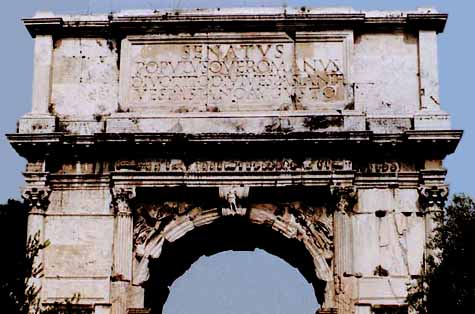 [Image: The Arch of Titus, via Wikipedia].
[Image: The Arch of Titus, via Wikipedia].
• • •Don’t miss
Part Two of this interview.



 In this installment we discuss cultural authenticity and the rise of archaeo-tourism; China, the pirating of ancient history, and plaster casts of statuary; A Funny Thing Happened On The Way To The Forum; the little-understood lost lifestyle patterns of the pyroclastically entombed Pompeii; and the urban military spectacles of imperial Rome.
In this installment we discuss cultural authenticity and the rise of archaeo-tourism; China, the pirating of ancient history, and plaster casts of statuary; A Funny Thing Happened On The Way To The Forum; the little-understood lost lifestyle patterns of the pyroclastically entombed Pompeii; and the urban military spectacles of imperial Rome.  [Image: A view of the Elgin Marbles, via the
[Image: A view of the Elgin Marbles, via the 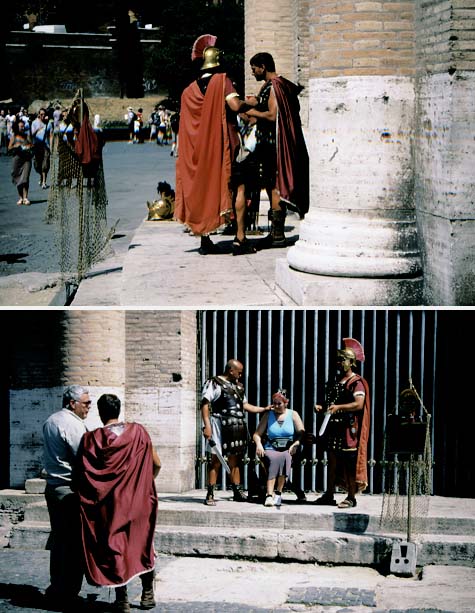 [Images: Tourists having their picture taken “next to somebody dressed up like a gladiator.” Photo by Robin Cormack].
[Images: Tourists having their picture taken “next to somebody dressed up like a gladiator.” Photo by Robin Cormack]. [Images: The streets of Pompeii, via
[Images: The streets of Pompeii, via  [Images: A Triumph through the streets of Rome following the sack of Jerusalem. For more on Roman Triumphs, don’t miss Mary Beard’s
[Images: A Triumph through the streets of Rome following the sack of Jerusalem. For more on Roman Triumphs, don’t miss Mary Beard’s  [Images: A poster for
[Images: A poster for  [Image: The Colosseum, photographed by Robin Cormack].
[Image: The Colosseum, photographed by Robin Cormack]. A few notable titles in that series include Mary Beard’s own book about
A few notable titles in that series include Mary Beard’s own book about 
 BLDGBLOG: When it comes to choosing an author to produce these books, do you go after people whose scholarly work you already admire – or do the authors come looking for you, pitching you ideas for a new monument or Wonder?
BLDGBLOG: When it comes to choosing an author to produce these books, do you go after people whose scholarly work you already admire – or do the authors come looking for you, pitching you ideas for a new monument or Wonder? [Image: The interior iron arches of London’s St. Pancras Station, via
[Image: The interior iron arches of London’s St. Pancras Station, via  [Image: Tourists visiting Auschwitz-Birkenau; photo via
[Image: Tourists visiting Auschwitz-Birkenau; photo via  BLDGBLOG: Most of the books now focus on sites around the Mediterranean – with some exceptions, but those exceptions are all European. Do you see the series going on to include non-European sites like Macchu Picchu or the Taj Mahal?
BLDGBLOG: Most of the books now focus on sites around the Mediterranean – with some exceptions, but those exceptions are all European. Do you see the series going on to include non-European sites like Macchu Picchu or the Taj Mahal? BLDGBLOG: I thought Cathy Gere’s book,
BLDGBLOG: I thought Cathy Gere’s book,  BLDGBLOG: I think a lot of this, though, comes down to the specific historical relationship between the countries involved. The U.S. having British artifacts in a museum means one thing, whereas, say –
BLDGBLOG: I think a lot of this, though, comes down to the specific historical relationship between the countries involved. The U.S. having British artifacts in a museum means one thing, whereas, say – [Image: Benito Mussolini, via
[Image: Benito Mussolini, via  [Image: The Arch of Titus, via
[Image: The Arch of Titus, via